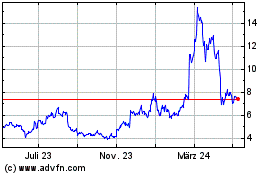Fidelity Director Analyzes Bitcoin Potential: Could It Hit $6 Trillion Market Cap?
24 Februar 2024 - 3:00AM
NEWSBTC
In recent years, the debate surrounding Bitcoin’s (BTC) potential
market share relative to gold has garnered significant attention,
as recently approved Bitcoin Exchange-Traded Funds (ETFs) can bring
Bitcoin significantly closer to gold in key metrics. Jurrien
Timmer, Director of Global Macro at Fidelity Investments, has put
forward an analysis that sheds light on this subject. By examining
the value of “monetary gold” and Bitcoin’s market capitalization,
as well as considering the impact of halvings on Bitcoin’s supply,
Timmer presents insights into the future dynamics of these two
assets. Gold Vs Bitcoin Timmer’s analysis begins by
estimating the share of gold held by central banks and private
investors for monetary purposes, excluding jewelry and industrial
usage. While this estimation is not exact, based on data from the
World Gold Council, Timmer suggests that monetary gold accounts for
approximately 40% of the total above-ground gold. Drawing upon his
previous calculations, Timmer posits that Bitcoin has the potential
to capture around a quarter of the monetary gold market,
with monetary gold valued at around $6 trillion and Bitcoin’s
market capitalization at $1 trillion. Related Reading: Avalanche
C-Chain Experiences Block Production Halt, AVAX Price Responds
Timmer further delves into the impact of Bitcoin halvings on its
price. Historically, halvings have had a substantial effect on
Bitcoin’s value. However, Timmer raises the hypothesis that
diminishing returns may occur in the future as the incremental
supply of new Bitcoin decreases. By comparing the outstanding
supply and incremental supply of Bitcoin with those of gold, Timmer
demonstrates that the diminishing impact of the halvings is likely
to be more pronounced in the future. As the number of coins
available for mining dwindles, the influence of each subsequent
halving event on Bitcoin’s price may diminish. This insight prompts
Timmer to explore alternative ways to project Bitcoin’s price
trajectory. BTC’s Price Projections To account for the diminishing
impact of halvings, Timmer introduces the concept of a modified
Stock To Flow (S2F) curve. This curve is derived by overlaying an
asymptotic supply curve, representing the percentage of coins mined
relative to the final supply cap, onto the original S2F curve.
Timmer proposes using a regression formula incorporating PlanB’s
original S2F curve and the asymptotic supply curve as independent
variables. This modified S2F curve aligns more closely with the
supply dynamics of gold, reflecting a scenario in which Bitcoin’s
scarcity advantage continues, but its impact on price gradually
diminishes over time. Using the modified S2F model and considering
the supply characteristics of gold, Timmer generates hypothetical
price projections for Bitcoin that place the cryptocurrency at
approximately $100,000 by the end of 2024. Related Reading: Uniswap
Foundation Unveils Major Upgrade Plan, UNI Price Skyrockets 52%
According to Timmer, if Bitcoin were to capture a quarter of the
monetary gold market, it would represent a remarkable shift in the
global distribution of wealth, which would gradually drive up the
cryptocurrency’s price over the coming years. Featured image from
Shutterstock, chart from TradingView.com
Uniswap (COIN:UNIUSD)
Historical Stock Chart
Von Mär 2024 bis Apr 2024

Uniswap (COIN:UNIUSD)
Historical Stock Chart
Von Apr 2023 bis Apr 2024
